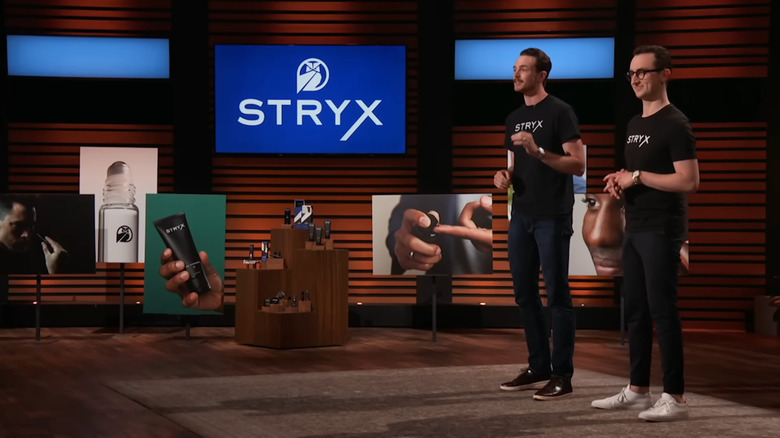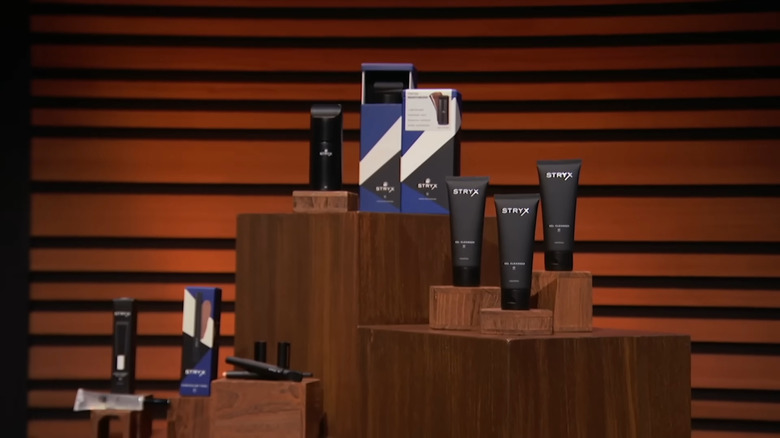Whatever Happened To Stryx After Shark Tank?
We may receive a commission on purchases made from links.
We're well into the 2020s, and men would still rather sport zits and eye bags than admit they use makeup. At least, that's what Devir Kahan and John Shanahan felt when they appeared on "Shark Tank" to pitch the panel of investors on their men's cosmetics company, Stryx. Zahan first realized the need for a company like Stryx on his wedding day — while everyone else was looking at the bride, he was looking at a mirror, agonizing over a truly volcanic zit. Unfortunately, he felt too embarrassed by the idea of wearing concealer to do anything but ignore it and, later, cringe at the thousands of photos taken that day.
On the other hand, Shanahan had been using cosmetic products since he was in high school but found the culture to be particularly cruel toward men who even dared to gel their hair. The bullying he experienced was apparently so brutal that he had to change middle schools. Nevertheless, the two men had overcome their past experiences and sought to change the way men think about makeup forever.
Before they could fight the stigma, Stryx had to fight the Sharks
The biggest challenge Stryx faces during its "Shark Tank" Season 13 appearance is its valuation. Asking for $600,000 in exchange for just 5% of the company, it asserts itself as a $12 million entity. Though Stryx had more than decent sales (at the time, it was averaging over $100,000 per month), this rich equity ask is seemingly an attempt to keep what little of the company Devir Kahan and John Shanahan had left in their control. Between the two of them, they only owned about 30% of Stryx.
As for the pitch itself, the aim of Stryx seems to be to make men more comfortable using makeup by offering it in brick-and-mortar retail stores (alongside its feminine counterparts) while keeping the packaging as discreet as possible so customers don't attract any unwanted attention. Mark Cuban takes issue with this stealth marketing approach and withdraws from negotiations.
Daymond John and Lori Greiner are next to bow out, leaving Stryx a choice between a classically greedy Kevin O'Leary royalty agreement or an equity deal with Robert Herjavec, who seeks 10% ownership in exchange for his investment. The entrepreneurs ultimately accept Herjavec's offer.
Stryx was ready to capitalize on their Shark Tank exposure
It's not uncommon for companies that appear on "Shark Tank" to receive a massive bump in sales throughout the days after the episode's airing. This is commonly referred to as the "Shark Tank Effect," and companies are usually given three weeks' notice via email if they will be included in an episode so that they can prepare their inventory; for example, the folks at Slick Barrier initially missed their email, leaving them scrambling right up until their episode's airing.
Fortunately, Stryx was prepared and then some for its own "Shark Tank Effect." One exemplary step the company took was putting together a "Shark Tank" pack for purchase on the Stryx website. Rather than being a makeup kit inspired by the show, it was instead a sampling of products the company had showcased during its pitch. This would be a savvy move for any "Shark Tank" company that relies on repeat customers, especially as it simplifies the buying experience for those potentially new not just to the company, but the entire market.
Another brilliant strategy they employed was leveraging their social media platform to help with brand education. Having smartly established a broad presence on various video-sharing platforms (most notably TikTok, where Stryx had over 200,000 followers at the time), a makeup tutorial was produced wherein John Shanahan teaches the viewer how to use their "Shark Tank" makeup kit.
Months after their appearance, Stryx got some tough -- and confusing -- news
If you're a casual fan of "Shark Tank," you may not know that the investors consistently change deals once the cameras are off. A handshake agreement during the taping is mostly just a handshake, with a protracted negotiating and due diligence period set to follow that could upend the deal for any number of reasons. Sometimes, however, the sharks don't give any reason at all.
This was apparently Stryx's experience, as John Shanahan revealed to Forbes in 2023 that his deal with Robert Herjavec evaporated without any explanation. "[Herjavec's team] told us they were not moving forward with no explanation why," Shanahan shared, "even though we asked several times."
On the plus side, Stryx has managed to stay in business and seems to be doing pretty well with customers as of writing. The company's TikTok account has gained over 100,000 new followers since the episode aired, and Stryx products boast rave reviews both on its own website and on Amazon.
Stryx is making all the right moves, but it may be fundamentally misguided
As Mark Cuban said during Stryx's "Shark Tank" pitch, "If you can convince bro culture to do it, you change everything." That appears to be the company's mission. Yet as admirable an aim as it is, Cuban's dubiousness about Stryx's ability to change the culture as a covert cosmetic product is telling — especially since they already have a competitor that's managed to strike a more even balance between discretion and ownership.
During Stryx's pitch, the entrepreneurs claimed they were the only men's cosmetic brand operating as they were. Whether they knew it or not, however, this wasn't necessarily true. Four years before Stryx appeared on "Shark Tank," War Paint was founded; the company markets makeup and skin care products to men by offering discreet packaging and simple options. What makes the two companies significantly different is that War Paint is more open about what it is, its name ambitiously targeting the macho bro Cuban believed Stryx needed to really make a difference.
More than War Paint, the existential threat to this sort of company is the (arguably likely) potential for cultural and gender norms to evolve without them. After all, in an age with notable public figures like Harry Styles, James Charles, and K-Pop star Jimin proudly showcasing their personal cosmetic style, it's less scandalous for men and non-female-identifying people of all genders to wear a bit of concealer. Should we see the day Stryx envisions where men can wear what they want, it's hard to imagine them as anything but a dwindling entry point if called to compete with companies like MAC, Fenty, Tom Ford, and Dior – all of which already sell gender-neutral products.




